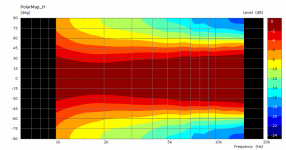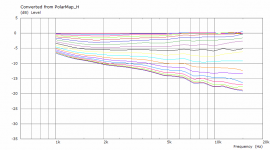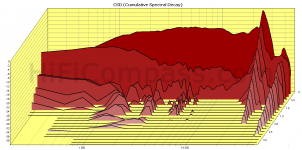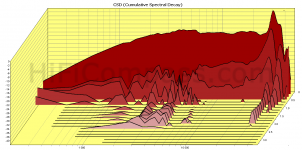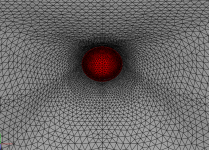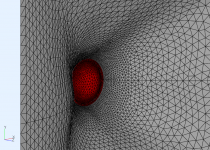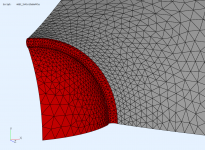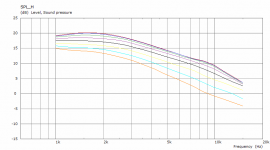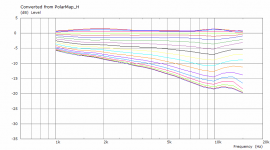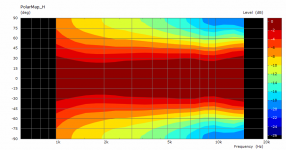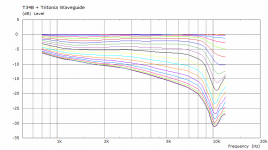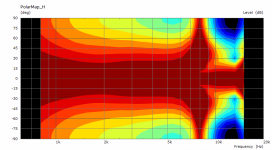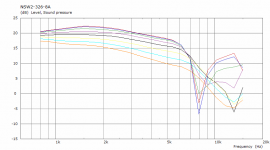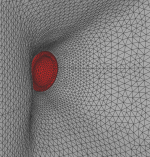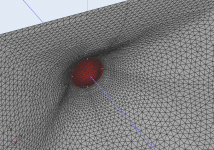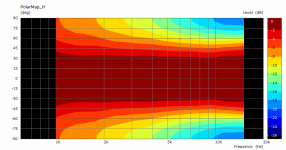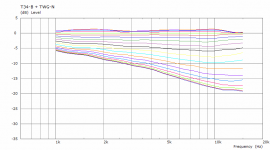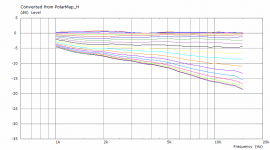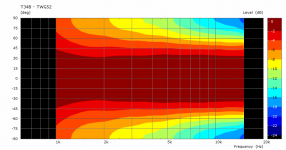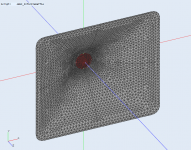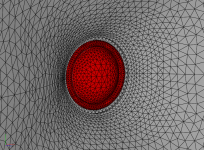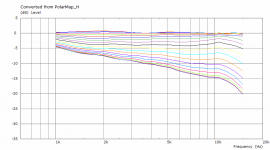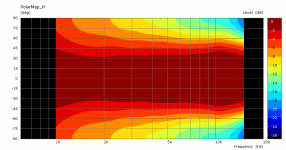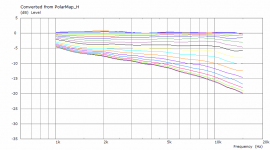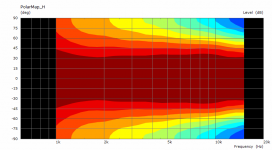I don't believe anyone would prefer a dip in a blind test systematically
They don't. It's a personal opinion.
I indeed can not generalize it for all the speakers ! This thing is at sweet spot on a triangle where side are longer than the base which is not an ideal listening position !
So at 1 m a speaker should be flat between 1 k and 20 kHz (+ has the constant directivity goodies) ?
So at 1 m a speaker should be flat between 1 k and 20 kHz (+ has the constant directivity goodies) ?
Back to the dome tweeter (T34-B) waveguide - I made the following one a little smaller (now it is 346 x 302 mm; the previous one was 450 x 390 mm).
The beamwidth actually widens with frequency a bit (although it is pretty constant for -6 dB). Makes me wonder if a slightly more beaming (and more loading) profile could/should be used in this case. I'll definitely give it a try.
(Again this is for an infinite baffle.)
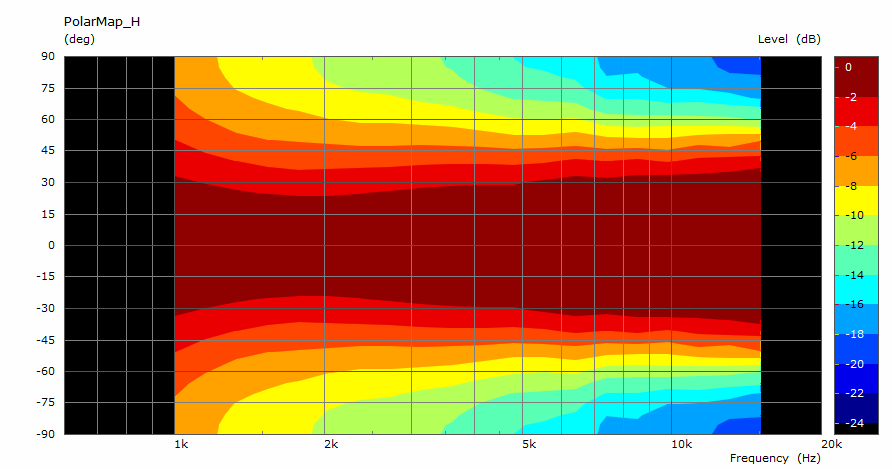
The beamwidth actually widens with frequency a bit (although it is pretty constant for -6 dB). Makes me wonder if a slightly more beaming (and more loading) profile could/should be used in this case. I'll definitely give it a try.
(Again this is for an infinite baffle.)
Attachments
storage energy is not where they perform best. Why not the peerless DX25 or DX32 instead ?!
I know you have trouble getting the model numbers of speakers correct but I think you are talking about the DA25 or DA32 as they use Corundum as the dome material.
Here is a comparison of the T34B and the DA25 from Hificompass as the graphs can be directly compared. I don't see a real issue with energy storage with either. DA25 left T34B right.
DA25 gets worse below 3K.
Attachments
The beamwidth actually widens with frequency a bit (although it is pretty constant for -6 dB). Makes me wonder if a slightly more beaming (and more loading) profile could/should be used in this case. I'll definitely give it a try.
You could change back to an OS profile, with an opening angle 5-10degrees less than the conical angle
Back to the dome tweeter (T34-B) waveguide - I made the following one a little smaller (now it is 346 x 302 mm; the previous one was 450 x 390 mm).
The beamwidth actually widens with frequency a bit (although it is pretty constant for -6 dB). Makes me wonder if a slightly more beaming (and more loading) profile could/should be used in this case. I'll definitely give it a try.
(Again this is for an infinite baffle.)
Would you care to show the mesh of the tweeter-horn interface?
That's quite insightful!You could change back to an OS profile, with an opening angle 5-10degrees less than the conical angle
I don't know exactly why, but with OS it gets worse around 10 kHz, even for a mild presence of it. This is for an opening angle 5 deg less than the conical angle (and it gets worse with increasing this difference). Maybe there's another way. BTW, non-axisymmetric shapes are far less sensitive to the "surround problem", it seems.
Anyway, I think this is a pretty good starting point.
Attachments
Last edited:
Attachments
2" Aurasound NSW2-326-8AT, the drivers S. Linkwitz used in his Plutos, in the same waveguide (modified for a different throat diameter, of course).
It would make a nice contest - to improve this
It would make a nice contest - to improve this
Code:
; Aurasound NSW2-326-8AT
point p1 -6.5 0 4
point p2 0 16.5 2
point p3 3 19.5 2
cpoint c1 17.69 0
cpoint c2 0 19.5
arc p1 c1 p2 1.0
arc p2 c2 p3 0.75
arc p3 c2 WG0 0.25Attachments
Last edited:
Anyway, the DA25TX (for which I have dimensions measured) is not as nice, seems to start beaming above 10 kHz in the same waveguide. It would probably require a different mounting interface and the same would probably hold for the DA32TX. The surround is convex here and not touching the wall of the WG.
Attachments
It seems that the concave surround is a good thing. The following is the same as the T34-B above but with the surround made convex. Even though not a night and day in this case, the effect is definitely recognizable. So the recommendation at the moment would be to look for a tweeter with concave surround that could smoothly join the waveguide (which is apparently even more important), I just don't know many.
I'll also try to cover the surround with the waveguide somehow but I'm afraid that will not improve things that much. So far I haven't tried to model any ring radiators.
danibosn, Boden: I'll get back to you.
I'll also try to cover the surround with the waveguide somehow but I'm afraid that will not improve things that much. So far I haven't tried to model any ring radiators.
danibosn, Boden: I'll get back to you.
Attachments
Last edited:
Anyway, the DA25TX (for which I have dimensions measured) is not as nice, seems to start beaming above 10 kHz in the same waveguide. It would probably require a different mounting interface and the same would probably hold for the DA32TX. The surround is convex here and not touching the wall of the WG.
Not sure as the DA32TX is falling faster off axis than its little sister ! In fact perhap with the same horn the 15k peak will looks good with the da32 ?!
Yeap a little disapointing the da25tx vs the T34...
how do you get "Converted from PolarMap_H" graph.
And, is it possible to export data from Vacs and import to Vituix? If it is, how to do it?
You click/select the polar graph you want to convert in VACS and then choose
Graph - convert curves <-> contour from the menu that will generate another graph. To get those curves out to Vituix select all the individual curves at the bottom of the graph. Select the first one then press and hold shift and click on the last one, they will go darker when selected. Then go to export the data from the menu, should default to Amplitude and phase and choose a file name.
Each curve will be exported separately in a numerical sequence.
To get them into Vituix they need to be renamed to the Arta style or something similar. I made a script to rename them to a format that will work using advanced renamer.
The script was attached in this post if it helps.
Acoustic Horn Design – The Easy Way (Ath4)
- Home
- Loudspeakers
- Multi-Way
- Acoustic Horn Design – The Easy Way (Ath4)
